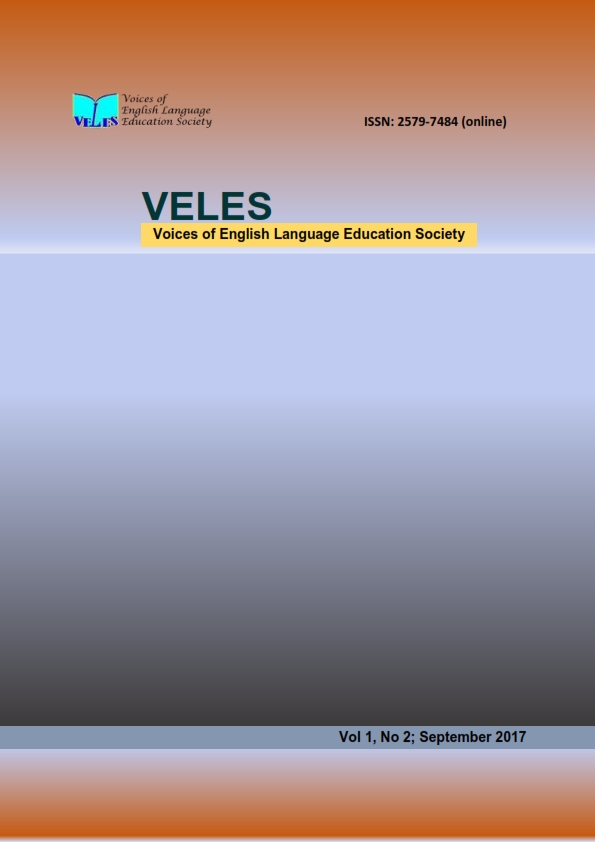The Use of Porpe (Predict, Organize, Rehearse, Practice, Evaluate) Strategy in Teaching Reading Comprehension
DOI:
https://doi.org/10.29408/veles.v1i2.436Abstract
This study aimed at examining the effectiveness of PORPE (predict, organize, rehearse, practice, evaluate) strategy in teaching reading comperhension.This research was designed as a pre-experimental research. The sample of this reserach was students of the tenth graders of Language 2 of MA Muallimin NW Pancor. In collecting the data, a pre-test and a post-test were given to students of the tenth graders of MA Muallimin NW Pancor in the school year 2015-2016. Descriptive statistic and paired simple t test were used to analyze the data by using SPSS 17.0 for windows. Based on the result of descriptive statistic, the mean score of post-test (20.59 ) was higher than pre-test (13.19). After submitting the data to a paired samples t-test, the present researcher found that there was a significant difference in the mean scores between the pre-test and the post-test, t(df=26) = 21.18 < p = 0.01, meaning that the alternative hypothesis was accepted. PORPE strategy is significantly effective in teaching reading comprehension of narrative texts for the tenth graders of MA Muallimin NW Pancor in the school year 2015-2016. Considering the process and the results of this research, the present researcher suggests that the English teacher should use PORPE strategy.
References
Ary, D., Jacobs, L. C., & Sorensen, C. (2010).Introduction to research in education (8thed.). USA: Wordworth, Thomson Learning.
Broughton, G., Brumfit, C., Flavell, R., Hill, H.,& Pincas, A.. (2003).Teaching English as a Foreign Language Second Edition. London and New York : university of London Instituteof Education
Brown, H. D. (2003). Principle of language teaching and learning. Engel Word Cliffs,NJ: Prentice Hall.
Carrel, P. L, Devine, J., &Eskey, D. E. (1993). Interactive approach to second language reading. New York: Cambridge University Press.
Cohen, L., Manion, L.,& Morrison, K.. 2005. Research Methods inEducation
Fifth edition. London & New York :Taylor & Francis e-Library.
Harmer, Jeremy. (2003). The practice of English language teaching.
London:Longman.
Hornby, A. S. (1995).Oxford advanced learners dictionary current
English.London: Oxford University Press.
Jenny Hammond. (1992.). English for Social Purposes, National Centre for
English Language Teaching and Reseach. Macquarie University Sydney.
Moedjito. (2015). Basic statistic for research in language education. Unpublished Modul: STKIP Hamzanwadi Selong, Nusa Tenggara Barat, Indonesia.
Newton’s First Law. EDUC 575: Study Skills Project. General Science Journal of
Developmental Education, 16(1). What is PORPE? Available at http://www.ncde.appstate.edu/reserve_reading/10_Recommendations_Ar
ticle.htm (accssed on December 28 2015) .
Simpson Michle L.(1986). PORPE: A writing strategy for studying and learning
in the content areas. Journal of Reading, 407-414.
Simpson Michele L., Norman A. Stahl & Christopher G. Hayes. (1989).
PORPE:A reseach validation. Journal of Reading, 22- 28.
Sudarwati, T. M., & Grace, E. (2007).Look Ahead: An English course book for Senior High School students year XII. Jakarta: Erlangga.
SuharsimiArikunto. (2006). Prosedur penelitian :Suatu Pendekatan Praktek (6th ed.).Yogyakarta: PT. Rineka Cipta.
Downloads
Published
How to Cite
Issue
Section
License
Authors who publish with VELES agree to the following terms:
- Authors retain copyright and grant the journal the right of first publication with the work simultaneously licensed under Creative Commons Attribution-ShareAlike 4.0 International License (CC BY-SA 4.0).
- Authors can enter into separate, additional contractual arrangements for the distribution of the journal's published version of the work (e.g., posting it to an institutional repository or publishing it in a book), with an acknowledgment of its initial publication in this journal.
- Authors are permitted and encouraged to post their work online (e.g., in institutional repositories or on their website) before and during the submission process, as this can lead to productive exchanges and earlier and greater citations of published work.
VELES is licensed under a Creative Commons Attribution-ShareAlike 4.0 International License.




